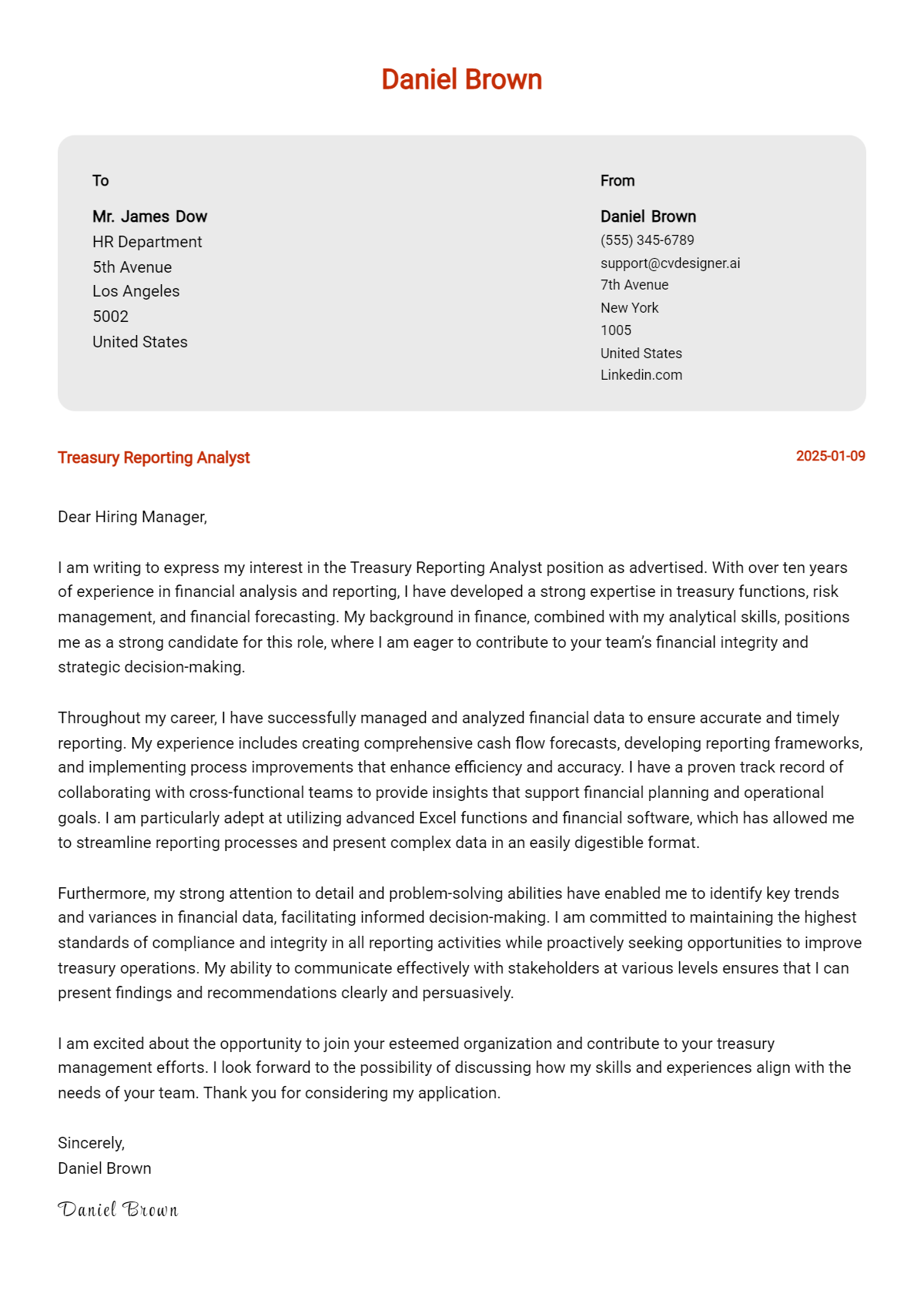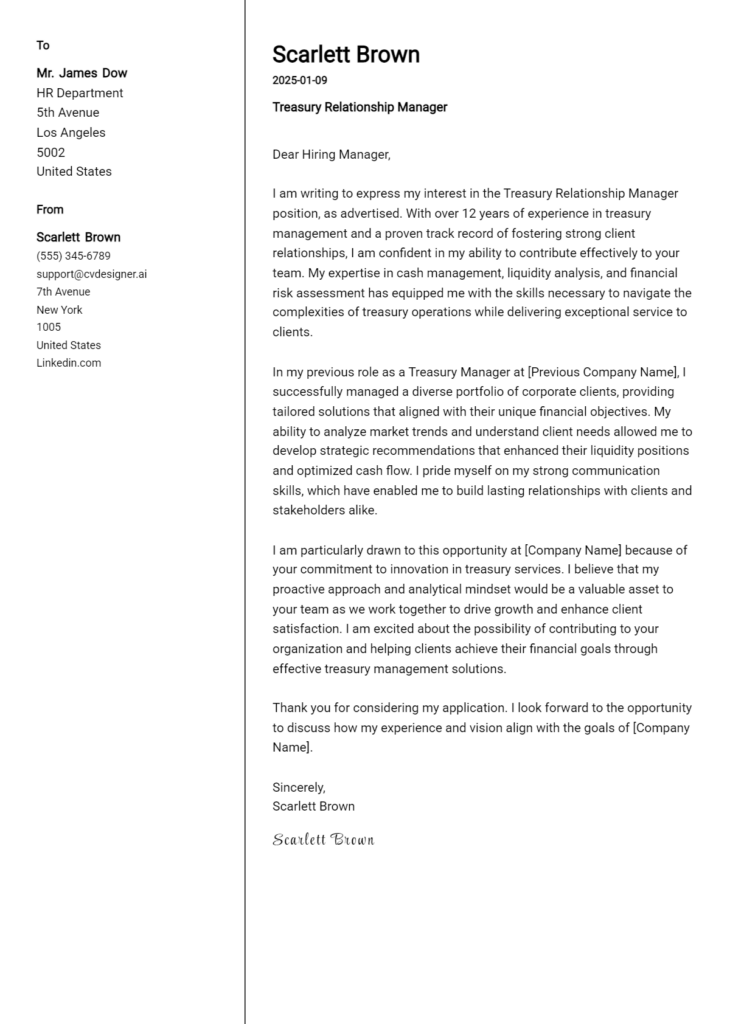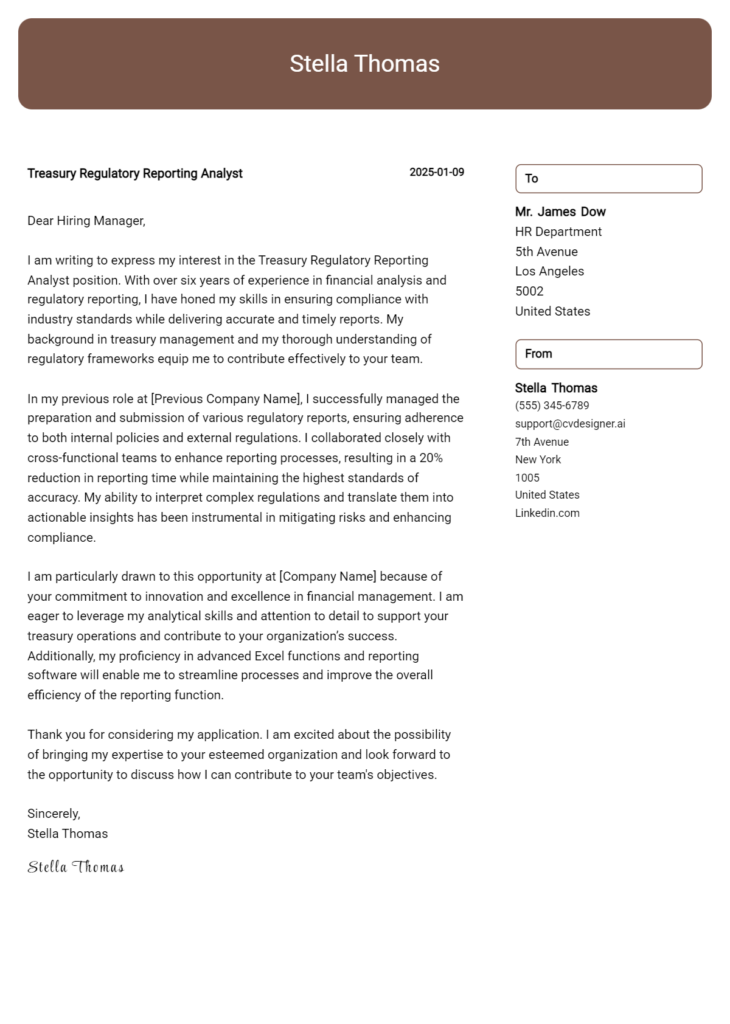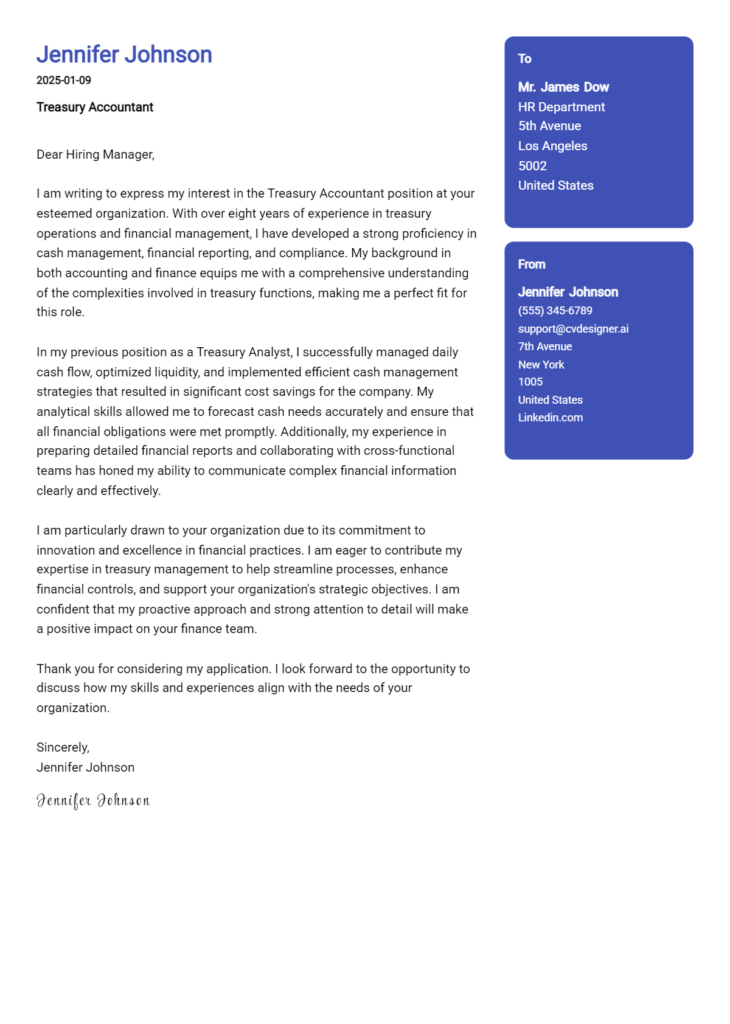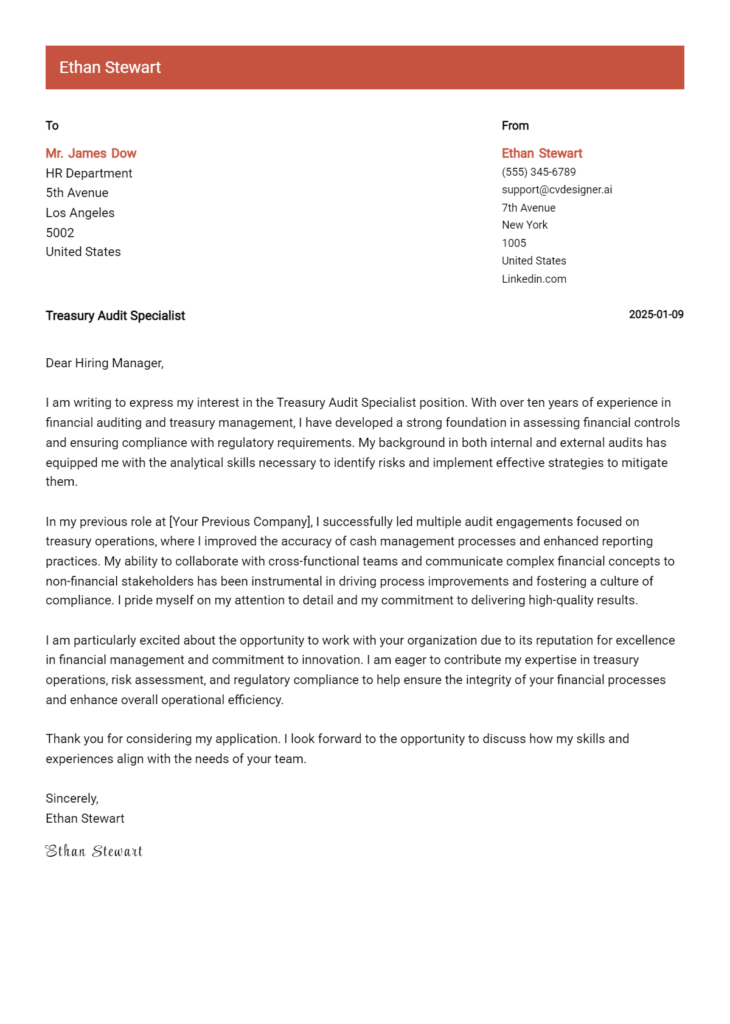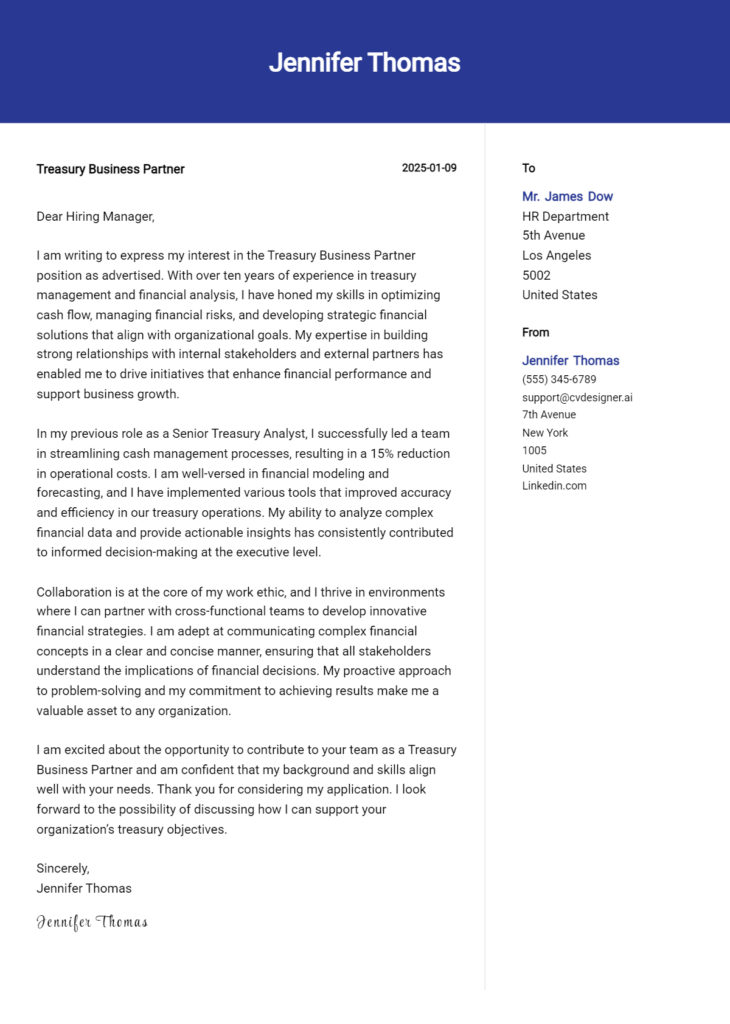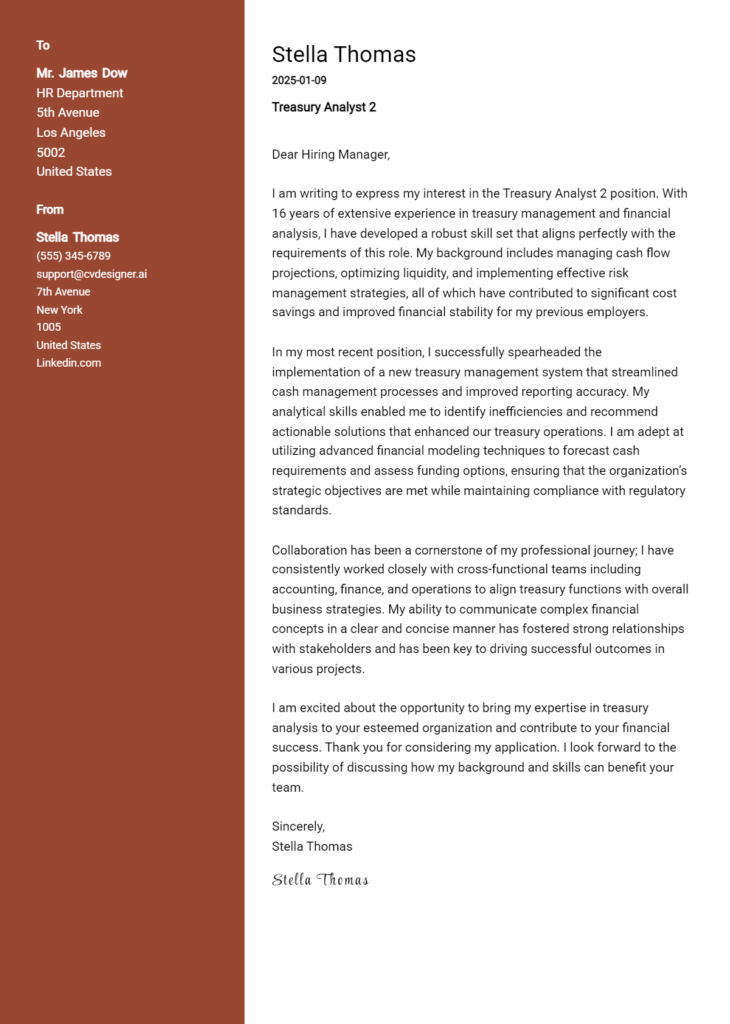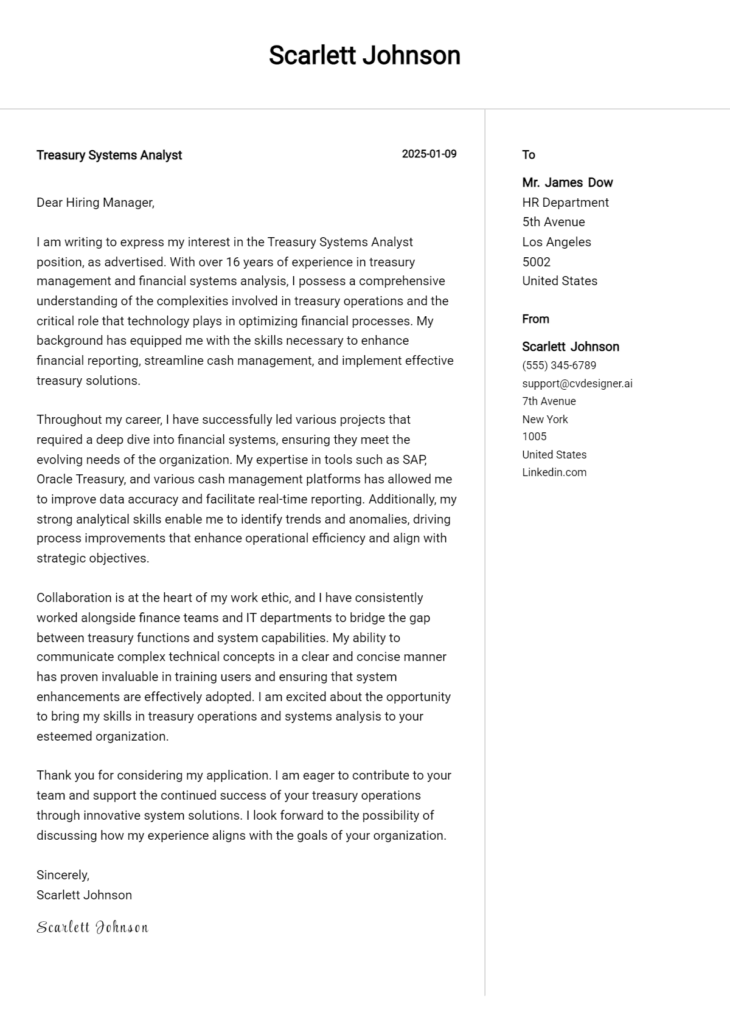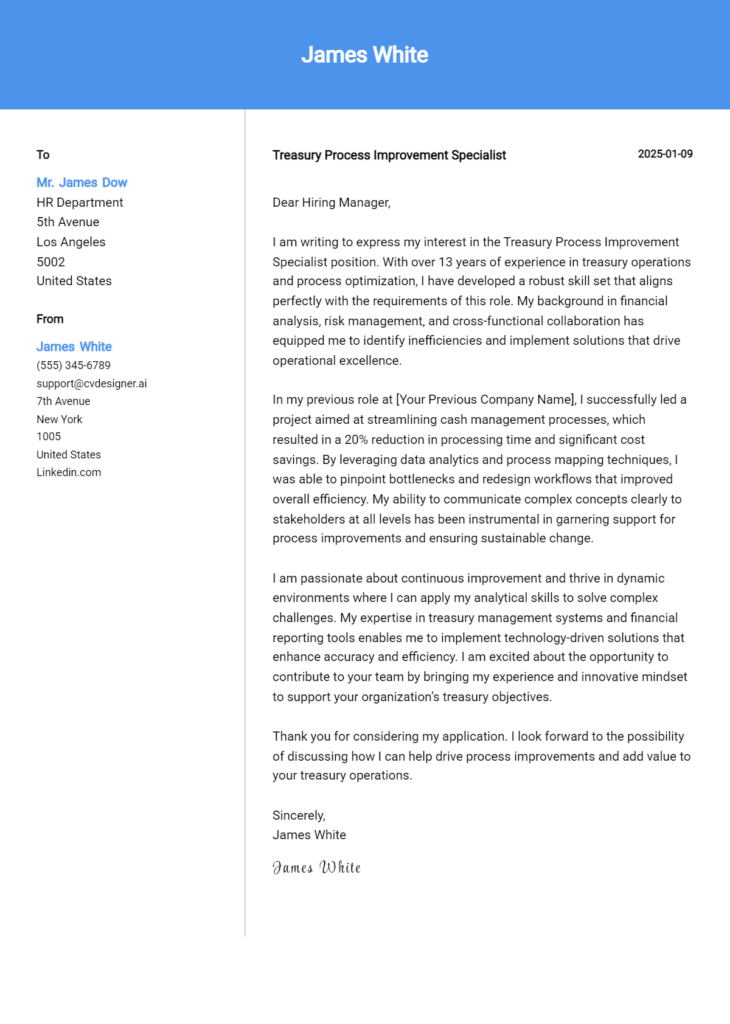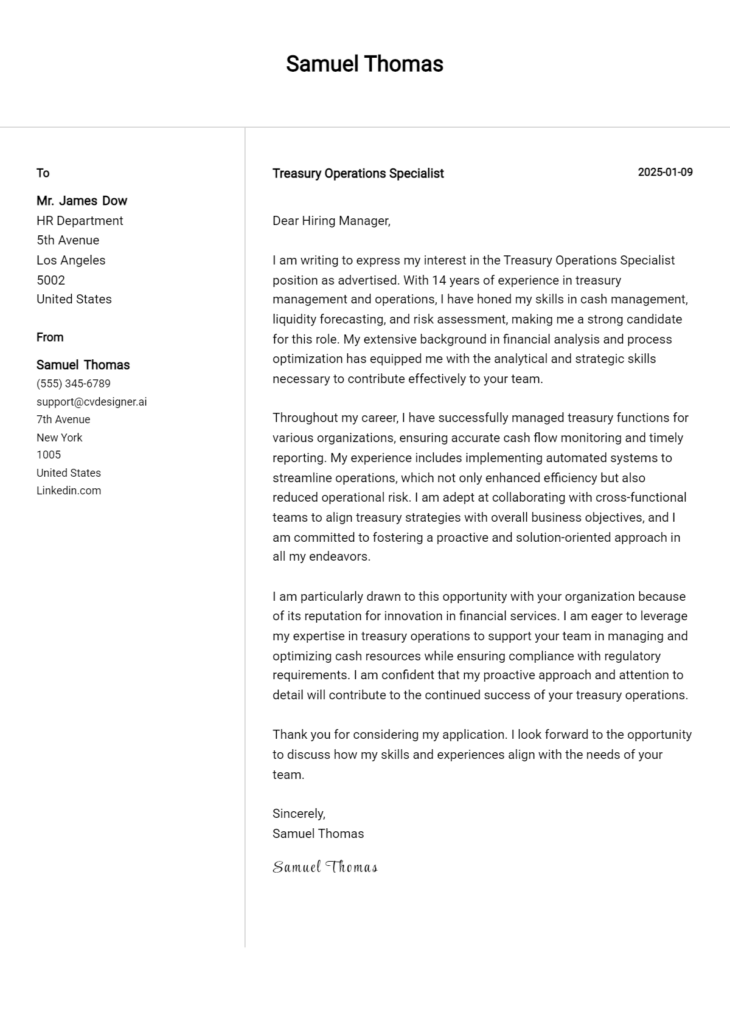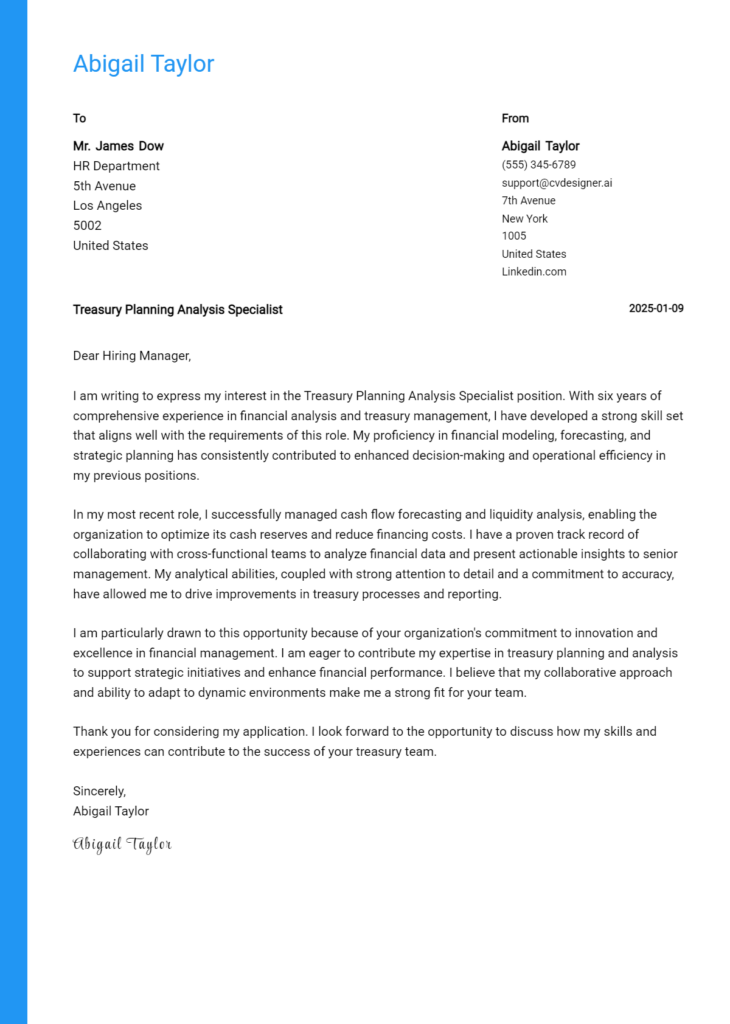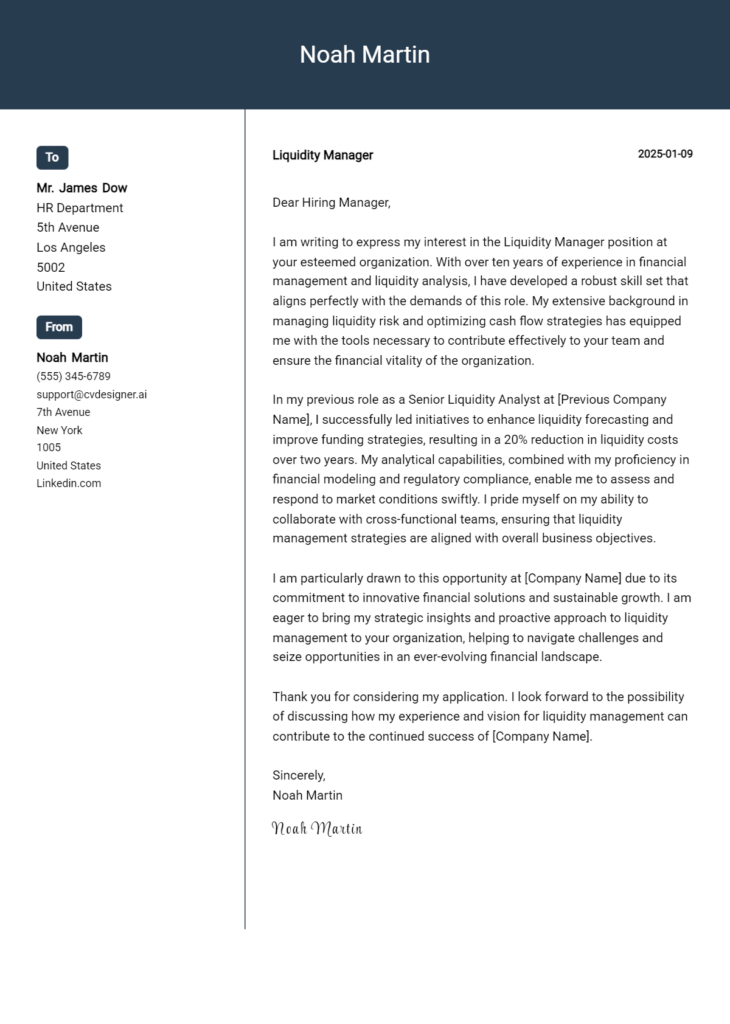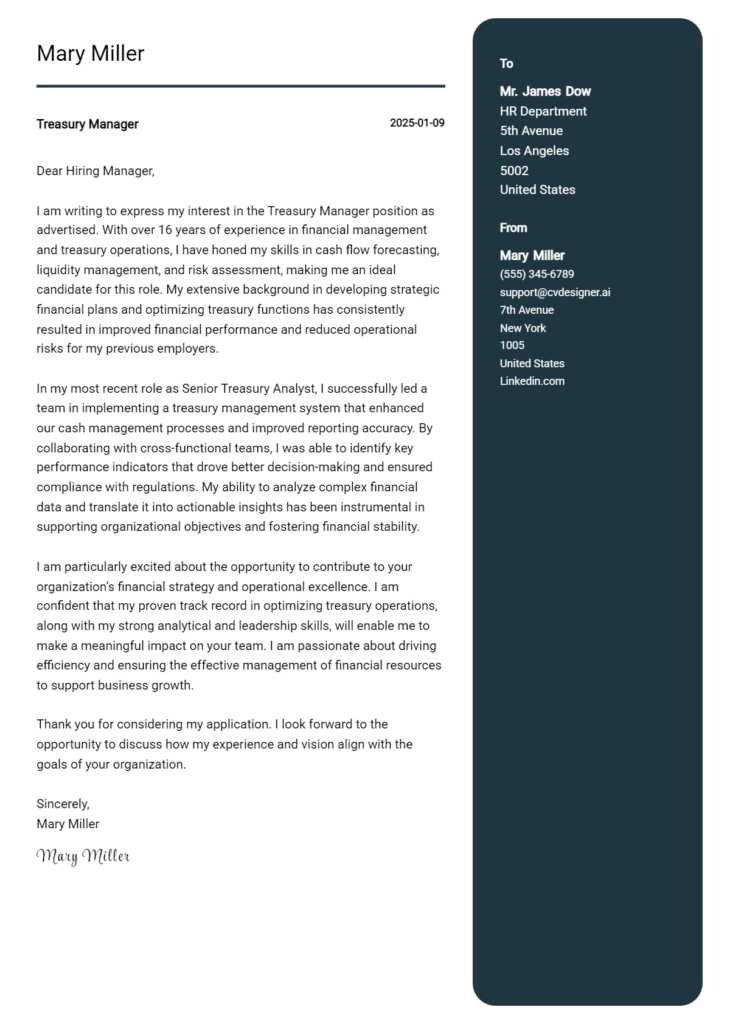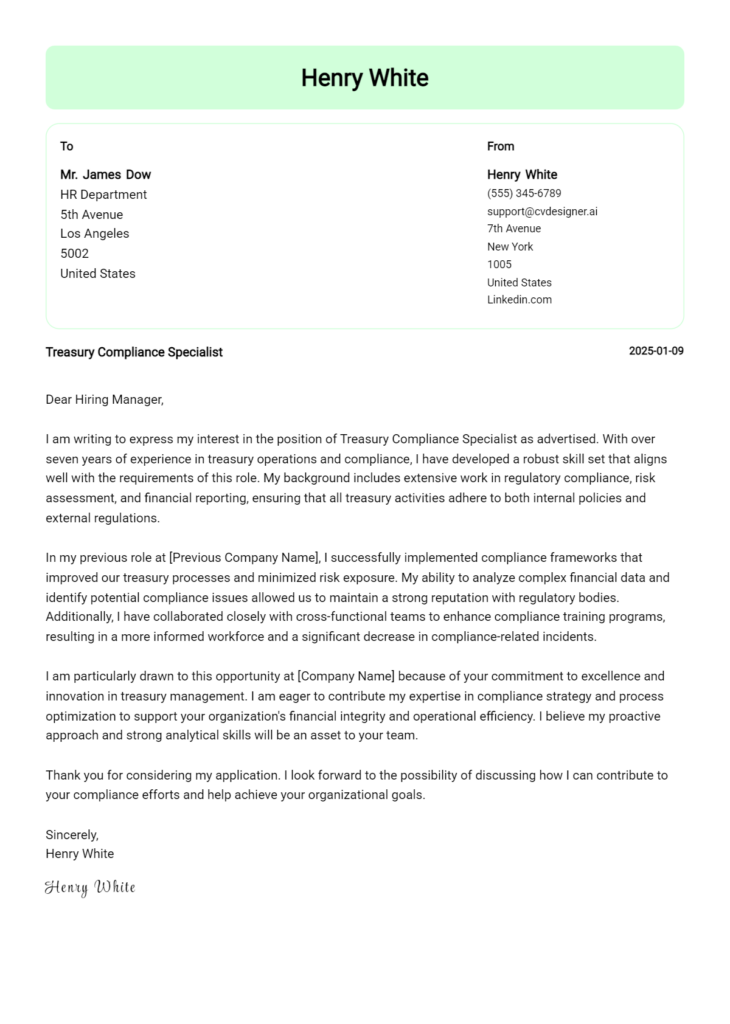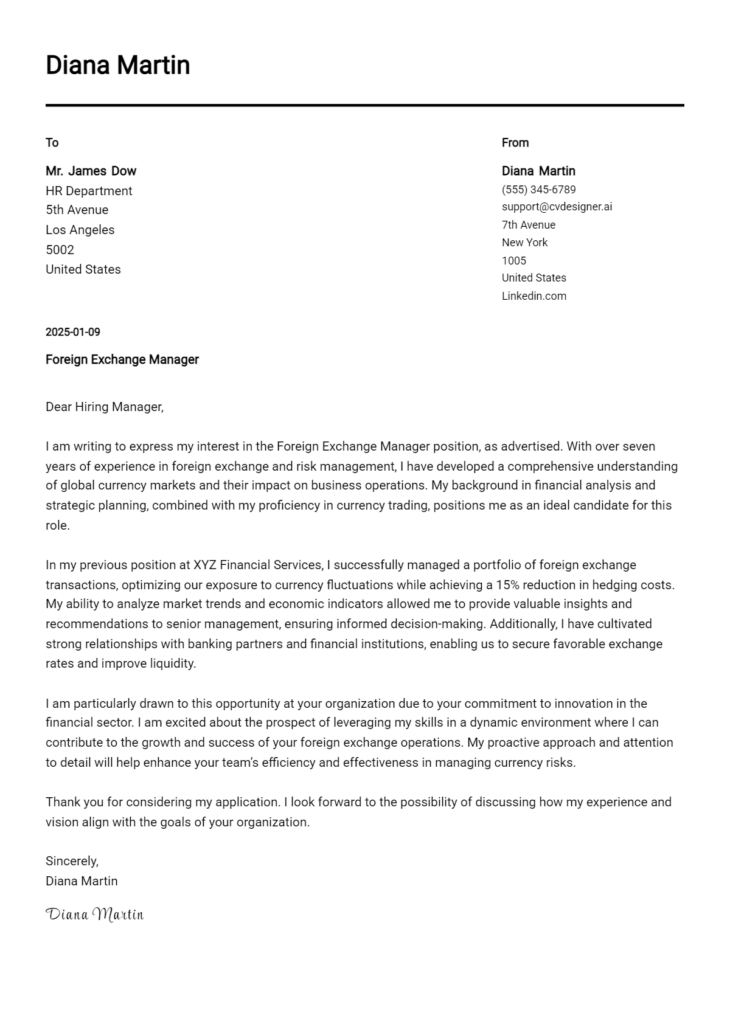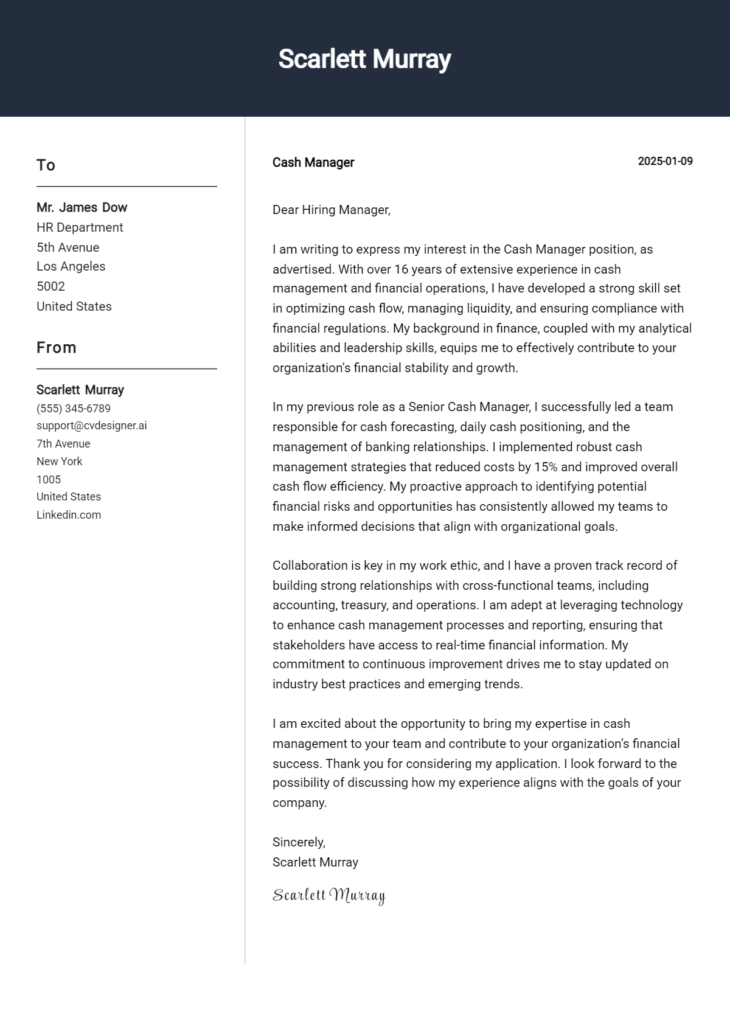Treasury Reporting Analyst Cover Letter Examples
Explore additional Treasury Reporting Analyst cover letter samples and guides and see what works for your level of experience or role.
How to Format a Treasury Reporting Analyst Cover Letter?
Crafting a well-structured cover letter is essential for a Treasury Reporting Analyst, as it serves as your first impression in a competitive job market. The way you format your cover letter not only showcases your qualifications but also reflects your analytical skills and meticulous attention to detail, both of which are critical in treasury management. A well-organized cover letter can capture the hiring manager's interest and demonstrate your ability to communicate clearly and effectively—skills that are vital in this role.
In this guide, we will discuss the key components of an effective cover letter, providing insights tailored to the treasury reporting field to help you create a standout document.
We'll focus on the essential elements of a professional cover letter, including:
- Cover Letter Header
- Cover Letter Greeting
- Cover Letter Introduction
- Cover Letter Body
- Cover Letter Closing
Each section is crucial for highlighting your qualifications and professionalism. Let’s break down each part and explain how to make your Treasury Reporting Analyst cover letter shine.
Importance of the Cover Letter Header for a Treasury Reporting Analyst
The cover letter header is a crucial component of your application as a Treasury Reporting Analyst, as it sets the tone for your professionalism and attention to detail. A well-structured header not only provides essential contact information, ensuring that the hiring manager can easily reach you, but it also includes the date and recipient's details, establishing a formal context for your correspondence. Clarity in your header reflects your organizational skills, which are vital in a role that involves financial reporting and analysis.
An effective header should include your name, address, phone number, email, the date, and the recipient's name and title, along with their company name and address. Below are examples of a strong and weak cover letter header for a Treasury Reporting Analyst position.
Strong Example
John Doe 123 Financial Lane Cityville, ST 12345 (123) 456-7890 john.doe@email.com March 15, 2023 Ms. Jane Smith Hiring Manager ABC Financial Services 456 Investment Blvd Cityville, ST 12345
Weak Example
John D. 12345 john@email March 15 Hiring Manager ABC Company
By crafting a strong header, you enhance your chances of making a positive first impression, which is essential in the competitive field of treasury analysis.
The Importance of the Cover Letter Greeting for a Treasury Reporting Analyst
The cover letter greeting is a crucial element that sets the tone for the rest of the letter. A well-crafted greeting not only establishes a connection with the hiring manager but also reflects your professionalism and attention to detail. Addressing the hiring manager directly demonstrates that you have taken the time to personalize your application, which can make a strong first impression. To avoid coming across as generic, it’s essential to research the recipient's name and title, if possible. This small effort can significantly enhance the impact of your cover letter, showing your genuine interest in the role.
Here are some examples of strong and weak greetings for a Treasury Reporting Analyst cover letter:
Strong Example
Dear Ms. Johnson,
Weak Example
To Whom It May Concern,
The Importance of a Compelling Cover Letter Introduction for a Treasury Reporting Analyst
A well-crafted cover letter introduction is crucial for capturing the attention of hiring managers, especially for a specialized role like a Treasury Reporting Analyst. This introduction serves as your first impression and sets the tone for the rest of your application. It should express your genuine interest in the position while highlighting key skills or accomplishments that align with the role. A strong introduction can distinguish you from other candidates, making it essential to articulate your value clearly and concisely. Below are examples of both strong and weak introductions to illustrate the impact of a well-written opening.
Strong Example
Dear Hiring Manager, As a dedicated Treasury Reporting Analyst with over five years of experience in financial analysis and reporting, I am excited to apply for the position at [Company Name]. My expertise in optimizing cash flow management and preparing detailed financial reports has consistently provided actionable insights that have driven strategic financial decisions. I am particularly drawn to this role because of [Company Name]'s commitment to innovation in financial services, and I am eager to contribute my analytical skills and passion for treasury operations to your esteemed team.
Weak Example
Hello, I am writing to apply for the Treasury Reporting Analyst position. I have some experience in finance and think I could do okay in this job. I noticed the company is looking for someone to help with reporting, which I have done before, so I thought I would send my application.
Purpose of the Cover Letter Body for a Treasury Reporting Analyst
The body of a cover letter for a Treasury Reporting Analyst serves as a critical platform for candidates to demonstrate their analytical skills, relevant experiences, and the unique value they can bring to the organization. This section should effectively highlight specific projects or accomplishments that align with the requirements of the job, showcasing the candidate's expertise in treasury management, financial reporting, and data analysis. By articulating their contributions to past roles, candidates can illustrate their ability to drive efficiency, enhance reporting accuracy, and support strategic financial decisions, ultimately making a compelling case for their candidacy.
Strong Example
Dear Hiring Manager, I am excited to apply for the Treasury Reporting Analyst position at XYZ Corporation. In my previous role at ABC Financial Services, I spearheaded a project that optimized cash forecasting processes, which resulted in a 20% reduction in working capital requirements. This initiative not only improved liquidity management but also enhanced our reporting accuracy. Additionally, my proficiency in financial modeling and advanced Excel functions enabled me to streamline monthly reporting, reducing the reporting cycle time by three days. I am eager to bring my analytical skills and proactive approach to your team, helping to improve treasury operations and support strategic financial planning. Sincerely, John Doe
Weak Example
Dear Hiring Manager, I want to apply for the Treasury Reporting Analyst job. I have worked in finance for a few years and have some experience with reporting. In my last job, I did some treasury-related tasks, like helping with cash flow statements. I am good at Excel and can do basic analysis. I hope to use my skills at your company. Best, Jane Smith
Importance of the Cover Letter Closing for a Treasury Reporting Analyst
The closing of a cover letter is a critical moment to leave a lasting impression on potential employers. It serves as a summary of your qualifications, reiterates your enthusiasm for the role, and encourages the next steps in the hiring process, such as reviewing your resume or scheduling an interview. A strong closing can reinforce your fit for the Treasury Reporting Analyst position, while a weak closing may leave doubts about your commitment or professionalism.
Strong Example
In closing, I am excited about the opportunity to bring my extensive experience in financial analysis and treasury management to your esteemed organization. My expertise in developing accurate reporting frameworks and my attention to detail align well with the requirements of the Treasury Reporting Analyst role. I look forward to the possibility of discussing how I can contribute to your team. Thank you for considering my application; I hope to speak with you soon to explore this opportunity further.
Weak Example
I guess I would be a good fit for this job. Please look at my resume when you get a chance. I hope to hear from you.
These tips will help candidates craft an effective cover letter for a Treasury Reporting Analyst position by emphasizing critical skills and experiences that employers seek. In this competitive field, showcasing your technical expertise, problem-solving abilities, knowledge of the Software Development Life Cycle (SDLC), teamwork aptitude, and a passion for continuous learning can set you apart. Let’s explore five detailed tips to enhance your cover letter and make a strong impression.
Cover Letter Writing Tips for Treasury Reporting Analyst
Highlight Technical Skills: Clearly outline your technical skills relevant to treasury reporting, such as proficiency in financial modeling, data analysis, and software applications like Excel, SQL, or specialized treasury management systems. Use specific examples to demonstrate how you have successfully applied these skills in previous roles, enhancing your credibility.
Demonstrate Problem-Solving Abilities: Treasury Reporting Analysts often face challenges that require innovative solutions. Share an anecdote where you identified a financial discrepancy or inefficiency and describe the steps you took to resolve it. This not only showcases your analytical mindset but also your ability to contribute to the organization’s financial health.
Emphasize SDLC Knowledge: If you have experience with software development or project management within the treasury context, mention it. Detail how understanding the Software Development Life Cycle has enabled you to effectively collaborate with IT teams or streamline reporting processes. This highlights your versatile skill set and ability to bridge finance and technology.
Showcase Teamwork: Treasury reporting often involves collaboration with various departments. Highlight your ability to work within a team by providing examples of past projects where teamwork was essential. Discuss your role in fostering communication and collaboration to achieve shared goals, demonstrating that you can contribute positively to the company culture.
Express a Passion for Continuous Learning: The finance and technology landscapes are ever-evolving. Convey your commitment to professional development by mentioning relevant certifications, courses, or workshops you have pursued. Illustrate how your eagerness to learn has benefited your previous employers and how it can continue to add value to the prospective organization.
By incorporating these elements into your cover letter, you will not only present yourself as a qualified candidate but also demonstrate your enthusiasm for the Treasury Reporting Analyst role.
Common Mistakes to Avoid in a Treasury Reporting Analyst Cover Letter
Crafting a compelling cover letter is essential for securing a position as a Treasury Reporting Analyst, as it serves as your first impression with potential employers. To enhance your chances of success, it's important to avoid several common pitfalls. Here are some mistakes to watch out for, along with tips to steer clear of them:
Generic Content: Failing to tailor your cover letter to the specific job can make you seem uninterested. Tip: Research the company and highlight relevant skills and experiences that align with the job description.
Overly Complex Language: Using jargon or complex terminology can confuse the reader. Tip: Keep your language clear and concise, focusing on your qualifications in a straightforward manner.
Lack of Specific Examples: Many candidates provide vague statements about their abilities. Tip: Use specific examples from past experiences that demonstrate your expertise in treasury reporting and analysis.
Ignoring Formatting: A cluttered or unprofessional layout can detract from your message. Tip: Use a clean, professional format with clear headings and consistent font styles to enhance readability.
Neglecting Proofreading: Spelling and grammatical errors can undermine your professionalism. Tip: Always proofread your cover letter or ask someone else to review it before submission.
Focusing Too Much on Responsibilities: Listing job duties without showing how you excelled in them can be ineffective. Tip: Emphasize achievements and the impact you made in previous roles rather than just your responsibilities.
Failing to Express Enthusiasm: A lack of enthusiasm can make you appear uninterested in the position. Tip: Convey your passion for treasury reporting and the specific organization, showing why you are excited about the opportunity.
By being mindful of these common mistakes, you can create a cover letter that effectively showcases your skills and makes a strong case for your candidacy.
Cover Letter FAQs for Treasury Reporting Analyst
What should I include in my cover letter for a Treasury Reporting Analyst position?
In your cover letter, highlight your relevant experience in financial analysis, forecasting, and reporting. Emphasize your proficiency with financial software and tools, as well as your understanding of treasury management principles. Include specific examples of how you've improved reporting processes or contributed to financial decision-making in previous roles. Additionally, mention your ability to work collaboratively with cross-functional teams and your attention to detail, which are critical in this role. Tailor your content to reflect the job description and the company’s values to demonstrate your genuine interest in the position.
How can I make my cover letter stand out for a Treasury Reporting Analyst?
To make your cover letter stand out, start with a compelling introduction that captures the hiring manager's attention. Personalize your letter by addressing it to a specific individual instead of using a generic salutation. Use quantifiable achievements to demonstrate your impact in previous roles, such as specifying how you improved reporting efficiency or reduced errors. Incorporate relevant industry terminology and show familiarity with the company’s treasury operations or challenges. Lastly, convey enthusiasm for the role and the value you can bring to the organization, making it clear why you are the ideal candidate.
Should I use a formal tone in my cover letter for this role?
Yes, maintaining a formal tone is essential in a cover letter for a Treasury Reporting Analyst position. The finance industry typically values professionalism and clarity, so your language should reflect that. Use clear, concise, and professional language throughout your letter. Avoid colloquialisms or overly casual phrases to ensure that you present yourself as a serious candidate. However, you can still inject a bit of personality to convey your enthusiasm for the role. Striking the right balance between professionalism and authenticity will help create a strong impression.
How long should my cover letter be for a Treasury Reporting Analyst application?
Your cover letter should ideally be one page long, consisting of three to four paragraphs. Aim for approximately 250 to 400 words to ensure that you provide enough detail without overwhelming the reader. Start with a strong opening, followed by a paragraph that outlines your relevant experience and skills. Use the next paragraph to discuss specific accomplishments or projects that demonstrate your fit for the role. Finally, conclude with a call to action, expressing your eagerness to discuss your application further. Keeping it concise will make it easier for hiring managers to read and remember your key qualifications.
Build your Cover Letter in minutes
Use an AI-powered cover letter builder and have your letter done in 5 minutes. Just select your template and our software will guide you through the process.

